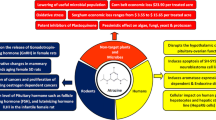Abstract
Cadmium, copper, lead, palladium, platinum, rhodium, and zinc profiles were investigated along feather shafts of raptor and other bird species by laser ablation inductively coupled plasma mass spectrometry (LA-ICP-MS). The distribution of external versus internal metal contamination of feathers was investigated. The species examined were peregrine falcon (Falco peregrinus), sparrowhawk (Accipiter nisus), willow grouse (Lagopus lagopus), and house sparrow (Passer domesticus) in Sweden. For habitat comparisons, total Cu, Pb, Zn, and Cd concentrations were analyzed by ICP-MS in feathers of the examined species as well as captive peregrine falcon. For investigation of metal distribution and correlation in different biological materials of raptors, total concentrations of Cu, Pb, Cd, and Zn were also investigated by ICP-MS in feathers, eggs, blood, feces, liver, and kidney of wild peregrine falcon from southwestern Sweden.
Laser ablation of feathers revealed that Pb contamination is both external and internal, Zn contamination is internal, and Cd and Cu contamination is predominantly internal, with a few externally attached particles of high concentration. Pb, Cu, and Cd signal intensities were highest in urban habitats and contamination was mainly external in feathers. The background signal intensity of Zn was also higher in birds from urban habitats. The laser ablation profile of PGE (Pt, Pd, Rh) demonstrated that PGE contamination of feathers consists almost exclusively of externally attached PGE-containing particles, with little evidence of internally deposited PGE.
Generally, total metal concentrations in feathers were highest in sparrowhawk and house sparrow due to their urban habitat. Total Cu, Zn, and Cd concentrations were highest in liver and kidney due to binding to metallothionein, while the total Pb concentration was highest in feces due to the high excretion rate of Pb. A decreasing temporal trend for Pb in feathers, showing that Pb levels in feathers have decreased since the introduction of nonleaded petrol, is also discussed.
Similar content being viewed by others
Author information
Authors and Affiliations
Rights and permissions
About this article
Cite this article
Ek, ., Morrison, ., Lindberg, . et al. Comparative Tissue Distribution of Metals in Birds in Sweden Using ICP-MS and Laser Ablation ICP-MS. Arch Environ Contam Toxicol 47, 259–269 (2004). https://doi.org/10.1007/s00244-004-3138-6
Issue Date:
DOI: https://doi.org/10.1007/s00244-004-3138-6




